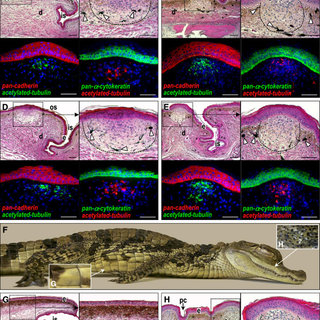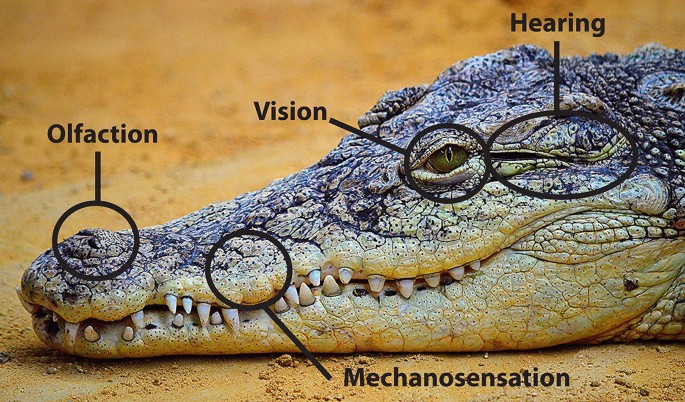Nile Crocodile Sensory Organs Masters of Detection
Nile Crocodile Sensory Organs Masters of Detection The Nile crocodile (Crocodylus niloticus) is one of the most formidable predators in the animal kingdom, found in a range of habitats across Africa, from rivers and lakes to swamps and coastal regions. To thrive in these diverse environments, Nile crocodiles have developed highly specialized sensory organs that aid in hunting, navigation, and communication. This article explores the unique adaptations of these sensory organs and their significance for the Nile crocodile’s survival.
Overview of Crocodilian Sensory Organs

Crocodilians possess a range of sensory adaptations that set them apart from other reptiles. While many reptiles rely primarily on vision and smell, Nile crocodiles utilize a combination of sensory modalities, allowing them to be highly effective predators. Their sensory systems are finely tuned for both aquatic and terrestrial environments, making them versatile hunters.
Vision
The Nile crocodile’s eyes are exceptionally adapted for life both in and out of water. Each eye features a nictitating membrane, a transparent eyelid that protects the eye while allowing vision underwater. Crocodiles have a higher ratio of rods to cones in their retinas, enabling them to see well in low light conditions and enhancing their night vision. While their color perception is limited, their ability to detect movement and contrast is highly developed. This is crucial for spotting prey and potential threats, especially during twilight or at night.
Hearing
Nile crocodiles have a well-developed auditory system that includes external ear openings capable of closing to prevent water entry. Their inner ear structure allows them to detect low-frequency sounds, which are often generated by the movements of prey or the vibrations of their environment. Hearing plays a vital role in communication with other crocodiles, especially during mating rituals, where vocalizations can convey territory and readiness to mate.
Here’s a table summarizing the sensory organs of Nile crocodiles, including their functions and adaptations:
| Sensory Organ | Structure/Adaptation | Function | Significance |
|---|---|---|---|
| Vision | – Nictitating membrane – High ratio of rods to cones | – Detects movement and contrast, especially in low light | – Critical for hunting and navigation in various environments |
| Hearing | – External ear openings – Advanced inner ear structure | – Detects low-frequency sounds | – Important for communication and locating prey |
| Olfaction | – Complex olfactory receptors | – Detects chemical cues in air and water | – Vital for tracking prey and finding mates |
| Taste | – Taste buds in tongue and throat | – Distinguishes between different food types | – Assists in identifying suitable prey |
| Tactile Sensation | – Sensory receptors in skin – Dermal pressure receptors – Integumentary sensory organs (ISOs) | – Detects touch, pressure, and vibrations | – Enhances ability to locate prey and sense environment changes |
| Electroreception | – Specialized electroreceptive structures | – Senses electric fields produced by living organisms | – Useful in murky waters where visibility is low |
Feel free to use or modify this table as needed!
Olfaction (Sense of Smell)

The olfactory system of Nile crocodiles is highly advanced, with a complex arrangement of olfactory receptors. This system is essential for locating prey from significant distances, as crocodiles can detect chemical cues in both water and air. Their sense of smell is particularly valuable for hunting, as they can track the scent of wounded animals or find potential mates during breeding seasons. This adaptation allows them to exploit a variety of food sources, enhancing their survival.
Taste
The taste buds of Nile crocodiles are primarily located on their tongues and in their throats. Though their sense of taste is less emphasized compared to other senses, it plays a role in feeding behavior. Crocodiles can distinguish between different types of food based on taste, which is often integrated with their olfactory cues. This sensory interaction is crucial for identifying suitable prey and avoiding potentially harmful substances.
Tactile Sensation

Nile crocodiles possess a rich array of sensory receptors in their skin that are sensitive to touch and pressure. These receptors include mechanoreceptors that can detect vibrations and movements in the water. Additionally, they have specialized dermal pressure receptors that help them sense changes in their environment, making it easier to locate prey. The presence of integumentary sensory organs (ISOs)—tiny, hair-like structures on the skin—enhances their tactile sensitivity, allowing them to detect even the slightest disturbances in their surroundings.
Electroreception
While less common in reptiles, electroreception is present in Nile crocodiles, allowing them to detect the electric fields generated by living organisms. This adaptation is particularly useful in murky waters, where visibility is low. By sensing the electric signals produced by potential prey, crocodiles can hunt effectively even when they cannot see their target.
Integration of Sensory Information

Nile crocodiles utilize a sophisticated integration of sensory information to hunt successfully. For instance, they combine visual cues with olfactory and auditory signals to locate prey efficiently. When stalking, they remain nearly motionless, relying on their acute senses to detect movement or vibrations. This multi-sensory approach enhances their ability to respond quickly and adaptively in various environments, whether in freshwater or saltwater.
Conclusion
The sensory adaptations of Nile crocodiles exemplify the intricate relationship between anatomy and survival in the wild. Their unique combination of vision, hearing, smell, taste, tactile sensation, and electroreception enables them to thrive as apex predators in their ecosystems. Understanding these adaptations not only highlights the complexity of these creatures but also emphasizes the importance of conservation efforts to protect their habitats and ensure their continued existence in the wild.
Tips for Studying Nile Crocodile Sensory Organs
Start with Basic Biology:
- Familiarize yourself with crocodilian biology and anatomy to understand how sensory organs fit into their overall physiology.
Utilize Visual Aids:
- Use diagrams and images of Nile crocodile anatomy to visualize the placement and structure of sensory organs. This can enhance comprehension and retention.
Focus on Adaptations:
- Pay attention to the specific adaptations that allow Nile crocodiles to thrive in their environments. Understanding the evolutionary significance of these adaptations can deepen your appreciation of their sensory systems.
Incorporate Comparative Studies:
- Compare the sensory organs of Nile crocodiles with those of other reptiles and animals. This can provide insight into their unique features and common evolutionary traits.
Explore Ecological Context:
- Consider how sensory organs impact the crocodile’s role in its ecosystem. Understanding their hunting strategies, mating behaviors, and territoriality can highlight the importance of their sensory adaptations.
Engage with Scientific Literature:
- Read scholarly articles and books on crocodilian biology and sensory systems. This can provide more in-depth information and current research findings.
Visit Aquariums or Zoos:
- If possible, observe Nile crocodiles in a controlled environment. Watching their behavior can give practical insights into how they use their sensory organs in real-life scenarios.
Conduct Hands-On Research:
- If you have access to field studies or lab research, participate in projects related to crocodilian biology. Practical experience can significantly enhance your understanding.
Join Online Forums or Groups:
- Engage with communities interested in herpetology or crocodilian studies. Discussing findings and insights with others can enrich your knowledge and understanding.
Stay Updated:
- Follow the latest research and conservation efforts related to Nile crocodiles. Keeping informed about new discoveries can provide a broader perspective on their sensory adaptations and ecological importance.
Here’s a list of frequently asked questions (FAQs) related to the sensory organs of Nile crocodiles:
FAQs about Nile Crocodile Sensory Organs
What sensory organs do Nile crocodiles have?
Nile crocodiles possess several sensory organs, including eyes (for vision), ears (for hearing), olfactory receptors (for smell), taste buds (for taste), skin receptors (for touch), and electroreceptors (for sensing electric fields).
How do Nile crocodiles see underwater?
Nile crocodiles have a nictitating membrane, a transparent eyelid that protects their eyes while allowing them to see clearly underwater. Their eyes are adapted to low-light conditions, enabling effective hunting during dawn or dusk.
What role does the sense of smell play in Nile crocodiles?
The sense of smell is crucial for Nile crocodiles, as it helps them detect chemical cues from prey, locate mates, and identify potential threats from a distance.
Can Nile crocodiles hear well?
Yes, Nile crocodiles have an advanced auditory system that allows them to hear low-frequency sounds, which is essential for communication, detecting prey, and recognizing environmental cues.
How do Nile crocodiles use their sense of taste?
While not as emphasized as other senses, taste helps Nile crocodiles distinguish between different food types. Their taste buds are primarily located on their tongues and throat, assisting them in identifying suitable prey.
What is electroreception, and how do Nile crocodiles use it?
Electroreception is the ability to detect electric fields produced by living organisms. Nile crocodiles use this ability, especially in murky waters, to locate prey that may be hidden from view.
How do tactile sensations help Nile crocodiles?
Nile crocodiles have sensitive skin with receptors that detect touch and pressure. This ability allows them to sense vibrations and movements in the water, helping them locate prey and navigate their environment.
How do Nile crocodiles integrate information from their sensory organs?
Nile crocodiles use a combination of sensory information to hunt effectively. They coordinate inputs from vision, hearing, smell, taste, and touch to track and capture prey, making them highly adaptable predators.
Are there differences in sensory abilities among crocodilian species?
Yes, different crocodilian species may have variations in sensory organ adaptations based on their specific habitats and ecological niches. Comparative studies can highlight these differences.
Why are the sensory organs of Nile crocodiles important for conservation?
Understanding the sensory adaptations of Nile crocodiles can inform conservation efforts. Protecting their habitats and addressing environmental threats can help maintain their populations and ecological roles in their ecosystems.
